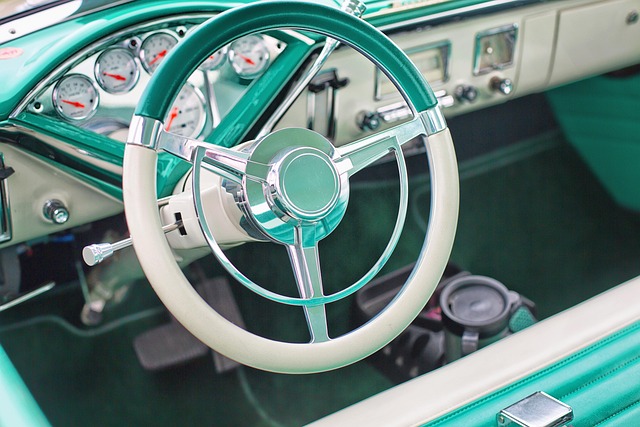Registering a car in California involves understanding specific requirements and navigating a straightforward process. This comprehensive guide walks you through every step, from gathering essential documents to completing the registration application at your local DMV. Key aspects include preparing for the required dmv vin verification, ensuring all necessary papers are in order, and understanding the associated fees. By following these steps, you’ll efficiently register your vehicle and hit the road legally.
- Understand California Vehicle Registration Requirements
- Gather Necessary Documents for Car Registration
- Visit Your Local DMV for VIN Verification
- Complete the Registration Application Process
- Pay Car Registration Fees and Receive Your Plate
Understand California Vehicle Registration Requirements

Before registering your vehicle in California, it’s crucial to understand the state’s specific requirements for vehicle identification number (VIN) verification. The California Department of Motor Vehicles (DMV) mandates a rigorous process to ensure the accuracy and authenticity of all registered vehicles. One key step is conducting a thorough VIN inspection, which helps establish the car’s history and identify any potential issues or discrepancies.
This process involves using reliable tools like a mobile vin verifier or undergoing a mobile vin inspection to cross-reference the provided VIN with state records. By adhering to these guidelines, you can ensure that your vehicle registration goes smoothly and complies with California’s stringent regulations.
Gather Necessary Documents for Car Registration

Before you begin the registration process, it’s crucial to gather all the essential documents for car registration in California. This includes your vehicle’s registration certificate from the previous state, a valid driver’s license, proof of insurance, and a completed Vehicle Registration Application form. One critical step is to undergo a DMV VIN verification process, which involves checking the vehicle’s unique identifier against the state’s records to ensure it matches the details on file.
Additionally, for added convenience, many residents opt for a mobile VIN inspection or verification service. This allows you to complete the necessary checks without visiting a DMV office. By having all these documents ready, you’ll streamline the registration process and quickly get your California car registration taken care of.
Visit Your Local DMV for VIN Verification

Before you can register your car in California, you’ll need to ensure that your vehicle passes a crucial step known as DMV VIN verification. This process involves verifying the Vehicle Identification Number (VIN) of your car to ensure it matches the records on file and is safe for road use. The best place to start this process is by visiting your local Department of Motor Vehicles (DMV) office.
At the DMV, you can request a vin inspection or even opt for a mobile vin verifier service that comes to you. This convenience allows for a smoother registration experience, especially if you have already completed other necessary steps like gathering your car’s documents and ensuring it meets all safety standards. A valid VIN inspection is essential for issuing your vehicle registration and license plate in California.
Complete the Registration Application Process

To complete the registration application process for your car in California, you’ll need to follow several steps. First, gather all required documents, including your vehicle’s title, proof of insurance, and valid driver’s license. Then, visit a California Department of Motor Vehicles (DMV) office or use their online services to initiate the registration. One crucial step is the DMV VIN verification, which ensures that your vehicle’s unique identifier matches the records.
You can streamline this process with a mobile vin verifier or undergo a mobile vin inspection for added convenience. This verification is an essential part of ensuring your car’s details are accurate and up-to-date. Once all information is confirmed, you’ll be on your way to securing your vehicle’s registration in California.
Pay Car Registration Fees and Receive Your Plate

After completing your car’s registration application at the DMV, the next step is to pay the required fees. These include the vehicle registration fee and a $25 license plate fee. You can typically pay online or in person at any California DMV office. Once your payment is processed, the DMV will perform a DMV vin verification, checking the vehicle’s history and ensuring it meets all legal standards. This process is crucial for safety and regulatory compliance.
Upon successful completion of the vin verification, you’ll receive your official license plate. In some cases, you might opt for a mobile vin inspection or use a mobile vin verifier to streamline the process, as these services allow for on-site vehicle checking and documentation. However, this step typically involves waiting for the DMV’s processing time before receiving your plates, ensuring your car is legally registered and ready for California’s roads.
Registering a car in California is a straightforward process that requires understanding specific requirements and gathering essential documents. After completing the application at your local DMV, you’ll undergo a crucial step of VIN verification, ensuring your vehicle’s authenticity. Upon approval, pay the necessary fees and receive your unique license plate, officially making your vehicle roadworthy in the Golden State. Remember to keep all registration documents up-to-date for smooth driving experiences.
